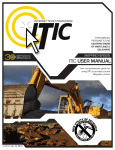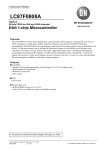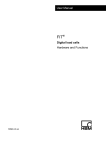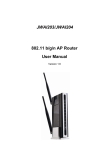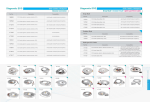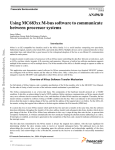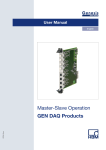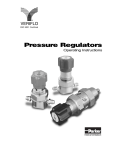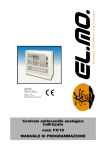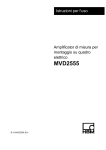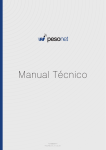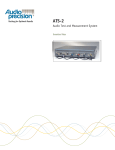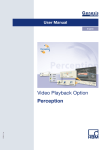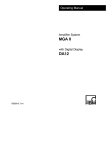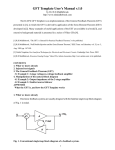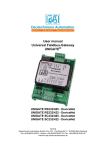Download AED9201B
Transcript
User Manual AED9201B Digital Transducer Electronics Basic Device RS232 or RS485 I1693-2.0 en Content 1 Content Typographical conventions................................................................................................ 3 Important information ......................................................................................................... 4 Safety instructions .............................................................................................................. 5 1 Introduction and appropriate use ...................................................................................... 6 2 Mechanical construction .................................................................................................... 7 3 Electrical connections ........................................................................................................ 8 3.1 Transducer connection......................................................................................................................... 8 3.2 Connecting the supply voltage.............................................................................................................14 3.3 Connection to a computer ...................................................................................................................15 3.4 Multi-channel measurements (bus mode, RS485) ...............................................................................18 3.5 Connecting the diagnostic bus.............................................................................................................20 3.6 Connecting digital inputs/outputs.........................................................................................................22 3.7 AED9201B cable connection via PG gland ..........................................................................................26 Index................................................................................................................................... 27 AED9201B en HBM 2 HBM AED9201B en Typographical conventions 3 Typographical conventions For clear identification and improved legibility, the following conventions have been used in this documentation: Important paragraphs are marked with a symbol to draw attention to them. CE Designation Statutory marking requirements for waste disposal Italics Points out external documents and files “File Open“ All menus and menu commands appear in quotes, here the “File” menu and the “Open” sub-menu. “Start” Quotes and italics are used for buttons, input fields and user input. MSV AED9201B en All commands are set out in a bold font style or as a link to the command description. HBM Important information 4 Important information Neither the design of the device nor any technical safety aspects may be modified without the express permission of Hottinger Baldwin Messtechnik GmbH. Any modification excludes Hottinger Baldwin Messtechnik GmbH from any and all liability for any damage resulting therefrom. It is strictly forbidden to carry out any repairs and soldering work on the motherboards or to replace any components. Repairs may only be carried out by persons authorized thereto by Hottinger Baldwin Messtechnik GmbH. All the factory settings are stored safe from power failure at the factory, not in the measuring amplifier where they can be deleted or overwritten. They can be reset at any time by using the command TDD0. For more information, see file aed_help_e, AD103C; “Description of the basic commands”. The production number is set at the factory and cannot be changed. The transducer connection must always be assigned. It is essential for a transducer or a bridge model to be connected up for operation. HBM AED9201B en Safety instructions 5 Safety instructions AED9201B en There are not normally any hazards associated with the product, provided the notes and instructions for project planning, assembly, appropriate operation and maintenance are observed. Each time, before starting up the modules, you must first run a project planning and risk analysis that takes into account all the safety aspects of automation technology. This particularly concerns personal and machine protection. It is essential to comply with the safety and accident prevention regulations applicable to each individual case. Installation and start-up must only be carried out by suitably qualified personnel. Do not allow the equipment to become dirty or damp. During installation and when connecting the cables, take action to prevent electrostatic discharge as this may damage the electronics. The required power supply is an extra-low voltage with safe disconnection from the mains. When connecting additional devices, comply with the local safety requirements. All the interconnecting cables must be shielded cables. The screen must be connected extensively to ground on both sides. The power supply and digital I/O connection cables only need to be shielded if the cables are longer than 30m (32.81 yd) or are routed outside closed buildings (EN 61326-1). The CE mark enables the manufacturer to guarantee that the product complies with the requirements of the relevant EC directives (the declaration of conformity is available at http://www.hbm.com/HBMdoc). In accordance with national and local environmental protection and material recovery and recycling regulations, old devices that can no longer be used must be disposed of separately and not with normal household garbage. If you need more information about waste disposal, please contact your local authorities or the dealer from whom you purchased the product. HBM Introduction and appropriate use 6 1 Introduction and appropriate use AED9201B digital transducer electronics are part of the AED component family that digitally conditions signals from mechanical measurement sensors and networks them with bus capability. These include digital amplifier motherboards, basic devices with serial interfaces and intelligent sensors with integrated signal processing. The purpose of these components is to directly digitize and condition the measurement signals at the transducer location. Using digital transducer electronics AED9201B, you can connect SG1) transducers in a fullbridge circuit directly to a computer or a PC. This enables you to configure complete measurement chains quickly and with little extra work. The AED9201B basic device contains the AD103C amplifier motherboard. It provides mechanical protection, shields the amplifier board (EMC protection), allows you to select the RS485 or RS232 serial interfaces and implements full electrical isolation of all connections. The AD103C amplifier motherboard is not included in the scope of supply of the basic device and must be ordered separately. Two digital inputs and six digital outputs allow: processes to be controlled via four limit values (LIV1…4) , triggered measured values (MAV) to be determined, a filling or dosing process to be controlled. The PC software AED PANEL 32 is available to facilitate parameter settings, to display dynamic measurement signals and for comprehensive analysis of the dynamic system. The HBM display unit DWS2103 can be connected to all AED basic devices. All basic devices of the AED family can be connected with the digital display unit DWS2103. This unit supports all implemented functions of the AED. The amplifier motherboard AD101B can also be used (spare part). All commands are described in the help file aed_help_e. The abbreviation AED is also used for transducer electronics in the following text. 1) HBM Strain Gage AED9201B en Mechanical construction 2 7 Mechanical construction The basic device extends the functionality of the AD amplifier boards and provides: mechanical protection (IP65) the power supply for the amplifier motherboard and transducer excitation (5 VDC ) total transducer bridge resistance 80…4000 a choice of serial interfaces RS485 (4-wire) or RS232 (electrically isolated from the amplifier) digital inputs/outputs (electrically isolated from the amplifier) EMC-tested Diagnostic bus Fig. 2-1: Mechanical construction AED9201B (without amplifier) The amplifier motherboard is designed as a plug-in board that can be plugged into the carrier board of the basic device via a 25-pin D-connector. The basic device contains terminals for the transducer, power pack and interface connections, slide switches for interface selection and the voltage stabilizer. The connection cables exit the casing via PG glands on the side. AED9201B en HBM Electrical connections 8 3 Electrical connections A connection diagram is attached inside the lid of the AED9201B basic device. When making the connections, please ensure that the wires of the cable do not protrude beyond the connection terminals (risk that loops may form). Please make sure that the cable shielding is properly connected to the PG gland (see the AED9201B cable connection via PG glands section). If it should be necessary, a separate cable can be used to establish potential equalization between the transducer and the AED and between the AED and the Master control unit (grounding concept). The cable shielding must not be used for this potential equalization. 3.1 Transducer connection The transducer connection must always be assigned (connect the transducer). Fig. 3.1-1: Transducer connection in 6-wire circuitry (HBM color-coding) HBM AED9201B en Transducer connection 9 You can connect SG transducers in a full-bridge circuit with a total bridge resistance of RB = 80...4000 . With a transducer resistance of > 1000 , increased noise (measurement ripple) must be taken into account. The bridges are supplied with power in the AED9201B basic device (5 VDC ). The bridge excitation voltage is electrically isolated from the external supply voltage. The 6-wire connection avoids the effect of a long cable on the measured value. When several transducers and a junction box are used, the 6-wire circuitry is routed to the junction box. Fig. 3.1-2: Transducer connection in the AED9201B basic device for a 6-wire connection There are two methods of connection for transducers implemented in four-wire circuitry: AED9201B en Connection via a 6-core extension cable; bridged sensor circuit in the transducer connector. Connection without an extension cable; sensor circuit bridged at the transducer electronics. HBM Transducer connection 10 Plug-in connection Transducer bu rd wh bk bu gn wh Cable to transducerelectronics gy bk Cable shield Fig. 3.1-3: Transducer connection in 4-wire circuitry via a 6-core cable extension Fig. 3.1-4: Transducer connection in 4-wire circuitry without a cable extension (jumpers 2 – 2‘ and 3 – 3‘) HBM AED9201B en Transducer connection 11 When connecting several transducers, it is advisable to use an HBM junction box VKKx. In general, the feed lines running to the AED should be shielded cables. Notes on type of connection, length and cross-section of cables: Depending on the bridge resistance of the load cell being used and the length and crosssection of the load cell connection cable, there may be voltage drops that can reduce the bridge excitation voltage. The voltage drop at the connection cable is also dependent on temperature (copper resistance). Likewise, the output signal of the load cell changes in proportion to the bridge excitation voltage. 6-wire circuit (standard mode of operation): This will correct all the effects of the load cell cabling up to the feedback points. Even changing the length of a cable after calibration will not make any difference to the measurement results. For load cells with a 6-wire connection, feedback lines 2´ and 3´ are bridged in the load cell with excitation 2 and 3 (Fig. 3.1-2). For load cells with a 4-wire connection, the feedback bridges must be implemented directly at the load cell connection (Fig 3.1-3 or 3.1-4). 4-wire circuit: As correction through AUTOCAL can only ever take place up to feedback points 2´, 3´, all the changes of cable resistances affect the measurement result. This means that even if no further changes are made to the 4-wire cable used for calibration, there will still be measurement errors when there are temperature changes, because the cable resistance and possibly the contact resistances at the connectors are temperature-dependent. With the 4-wire circuit, feedback lines 2´ and 3´ are directly connected at connection terminals 2 and 3 in the AED (see Fig. 3.1-4). AED9201B en HBM Transducer connection 12 Equivalent circuit of the bridge with bridge resistance RB and supply lines with line resistances RL1 and RL2: RL1 = RL2 = (4 pCU /) (I [m] / A [mm2]) RL1 pCU = 0,0178 [ mm2/m] for copper RB RL2 UBR = 3,14 I = Length of cable, A = Cross-section of cable RL1 = RL2 = 1,6 bei I = 10 m and A = 0,14 mm2 The voltage drop over the bridge feeder cables can be determined from bridge resistance RB, cable length l, cable cross-section A and the bridge excitation voltage: UB + URL1 + URL2 = UBR For RB = 80 , RL1 = RL2 = 1.6 (l = 10 m) and UBR = 5 V there is an excitation current of IBR = UBR/(RL1 + RL2 + RB) = 60 mA and thus a voltage drop over the two line resistances totaling approx. 0.32 V (UBridge = 4.8 V). For RB = 80 , RL1 = RL2 = 16 (l = 100 m) and UBR = 5 V there is an excitation current of IBR = UBR/(RL1 + RL2 + RB) = 45 mA and thus a voltage drop over the two line resistances totaling approx. 1.4 V (UBridge = 3.6 V). HBM AED9201B en Transducer connection 13 This is irrelevant for the 6-wire circuit, as the voltage drop over the sensor lines is taken into account in the measurement signal. But with a 4-wire circuit, the dependency of the copper resistance of the cables on temperature goes directly into the measurement result, as the bridge excitation voltage UBridge changes: RL(t) = RL20 (1 + (t – 20 °C)), where RL20 is the line resistance at 20°C and is the temperature coefficient of the copper. RL20 – calculation see p. 13, CU := 0.00392 [1/K] With a cable length of l = 100 m and a temperature differential of 10 °C, there is a line resistance of RL1(t) = RL2(t) = 16 (1 + 0.00392 10) = 16.6 This changes the bridge excitation voltage of UBridge = 5.7 V (at 20°C) to UBridge = 3.53 V. This change in bridge excitation voltage directly at the transducer changes the measurement signal of the bridge by 1.9 % (= 100 % (1 – 3.53 V / 3.6 V)). This typical calculation shows that if long cables are involved, only 6-wire circuitry should be used. AED9201B en HBM Connecting the supply voltage 14 3.2 Connecting the supply voltage The power supply must meet the following requirements: AED9201B DC voltage +15...+30 V (nominal 18...30 V) Current consumption <175 mA (without bridge) Current consumption <275 mA (for an 80 bridge resistance) Fig. 3.2-1: Power supply connection The voltage feed must be shielded. It can be applied within the interface cable or be implemented as a separate cable. When supplying several AEDs via one cable, the voltage drop over the cable must be taken into consideration. The voltage drop depends on the supply current required and on the line resistance. HBM AED9201B en Connection to a computer 3.3 15 Connection to a computer The basic device can be set to two interface variants (changeover switch on the AED9201B board). Fig. 3.3-1: Pin assignment for the RS232 and RS485 interfaces AED9201B en HBM Connection to a computer 16 No bus mode The RS232 interface allows the AED to be connected directly to a PC. The cable length is limited to 15 m and bus mode is not possible. B Fig. 3.3-2: Connecting an AED to a computer via the RS232 interface HBM AED9201B en Connection to a computer 17 Bus mode The RS485 interface with a 4-wire connection allows the full range of AED functions with a maximum cable length of 1000 m. To connect the AED to the COM port of a PC (RS232), you need an interface converter (1-SC232/422B from HBM). Basically, shielded cables should be used for the interface wiring, with the cable shielding being connected to the AED housing via the PG. (see AED9201B cable connection via the PG gland). The power supply can also be connected via this cable, with a 6-core, shielded cable being necessary. If it should be necessary, a separate cable can be used to establish potential equalization between the bus nodes. The cable shielding must not be used for this potential equalization. For reasons of electromagnetic compatibility, it is advisable to use a double-shielded cable (from the HBM program, for example: 3 2 0.14 m² , 4-3301.0076). SUB-D connector 9-pin (PC) PIN 2 = RxD 3 = TxD 5 = GND SUB-D female connector 9-pin (converter) PIN 2 = TxD 3 = RxD 5 = GND Fig. 3.3-3: Connecting an AED to a computer via RS232 and the supply voltage Die DTR control line for communication with the AED is not required. AED9201B en HBM Multi-channel measurements (bus mode, RS485) 18 3.4 Multi-channel measurements (bus mode, RS485) With the RS485 interface, several AEDs can be connected to a common bus line. The bus cabling for 4-wire mode is shown in Fig. 3.4-1. With the RS485 interface, up to 90 AEDs can be connected to a common bus line. With the aid of the RS485 bus driver, it is possible to implement long cables (up to 1,093.61 yd in length). AED bus mode is set out as a Master-Slave configuration, with the AED implementing a slave. This means that all the AED activities are initiated from the control computer. Each AED is given a separate communication address (00...89) and can then be activated by an Sii (ii = 00...89) Select command. A broadcast command (S98) is implemented for specific communication situations. This means that after a command of this type, all the AEDs execute the command of the Master, but none of the AEDs respond. All these communication commands are described with relevant examples in aed_help_e, AD103C, “Description of the basic commands”. Fig. 3.4-1: Bus structure 4-wire bus (general) The termination resistances of 500 marked in Figure 3.4.1 are important for the electrical function of the bus system. These resistances safeguard the quiescent level for the receiver on the bus line. The physical circuit must only be connected with these resistances at the line ends. HBM AED9201B en Multi-channel measurements (bus mode, RS485) 19 For the local bus termination distribution shown in the diagram, the Master and the AED with address 89 should include the termination resistances. Which is why, in this AED, the bus connection is activated with the commands STR1; and TDD1; (see aed_help_e, AD103C; “Description of the basic commands”). The HBM interface converter also includes these bus termination resistances (do not deactivate them). These terminations must not be activated more than twice in one bus. The wiring must not be in the shape of a star. The best wiring method is to loop the physical circuit through from AED to AED. The basic device has 2 PG cable entries for this. The ground of the interface driver is related to the GND terminal. The interface driver of the master should be also connected to this GND. The quiescent level on the RS485 physical circuit is produced in 4-wire mode at: TB - TA > 0.35 V (Rest level though AED termination resistances) RB - RA > 0.35 V (Rest level though Master termination resistances) As the RS485 is a differential bus interface, the rest level is also specified as a differential voltage between the lines (and not ground-related). Furthermore, please note that this interface tolerates a maximum common-mode range of ±7 V. AED9201B en HBM Connecting the diagnostic bus 20 3.5 Connecting the diagnostic bus The diagnostic bus is used to analyze dynamic processes. The bus is set out as an RS485 2-wire bus (lines: TB/RB and TA/RA, GND). Fig. 3.5-1: Connecting the diagnostic bus via terminal KL1 The interfaces setting of the bus is defined and cannot be changed (38400 bit/s, 8E1). External bus termination resistances are not necessary for this bus. The HBM interface converter can be used to connect the RS485 bus to an (RS232) COM port of the PC. HBM AED9201B en Connecting the diagnostic bus 21 Fig. 3.5-2: Diagnostic RS485 bus The ground of the interface driver is related to the GNDext terminal. The interface driver of the master should be also connected to this GNDext. Only a connecting cable with a screen grounded on two sides should be used as the interconnecting cable between the AED 9201B and the bus and the master (see also: AED9201B cable connection via a PG gland). The functions and commands of the diagnostic channel are described in the help file aed_help_e Diagnosis. The address corresponds to the address of the AD103C amplifier, command ADR (00...89, factory setting: 31), see aed_help_e, Basic Commands). This address is independently from the CANOpen address. The following functions can also be executed via this bus: Parameters Read only (changes are not possible) Measured values Reading individual measured values MSV?; (MSV?i not possible) Results Trigger results and dosing results can be read The diagnostic functions can be executed using the HBM AED_Panel32 program (as from Version V3.0.0). The HBM display unit DWS2103 can be connected with this interface. Than all implemented functions and parameters are accessible. This is independent from the main communication channel. AED9201B en HBM Connecting digital inputs/outputs 22 3.6 Connecting digital inputs/outputs The measuring amplifier is electrically isolated from the supply voltage, the interface connection and the digital I/Os. These connections relate to the GND potential of the external supply voltage. Fig. 3.6-1: Connection of digital I/Os, inputs IN1/2 electrically isolated by ext. power pack 2 (IN1=trigger) Inputs IN1/2 are electrically isolated from the external supply voltage UB , as well as from the amplifier ground. The ground connection of both the inputs is initially connected to the ground of supply voltage UB . Logic level : IN1: Trigger: Break Dosing IN2: Taring or start dosing HBM Quiescent level = low, active edge = high-low edge Quiescent level = low, (duration 20 ms) Activation = low-high-low-Puls Quiescent level = low, (duration 20 ms) Activation = low-high-low-Puls AED9201B en Connecting digital inputs/outputs 23 Unused inputs remain open. If the input circuit is also supplied via UB, the ground of the inputs and the ground of the UB must be connected. Fig. 3.6-2: Connection of digital I/Os, inputs IN1/2 not electrically isolated from UB (same power pack), (IN1 = trigger) Digital outputs OUT1...6 are electrically isolated from the amplifier and are supplied via UB . They are implemented as H-side switches. Consequently, consumers must be connected to ground (see Fig. 3.6-2). The outputs are short-circuit-proof and can drive ohmic and inductive loads with currents up to approx. 0.5 A per output. Logic level: OUT inactive voltage is Low (H-side switches deactivated) OUT active voltage is High (H-side switches activated) The functions of the digital inputs and outputs differ in accordance with the type of measuring amplifier used. AED9201B en HBM Connecting digital inputs/outputs 24 Function of the digital inputs/outputs The AD103 amplifier board has two inputs and 6 outputs. The functions are defined using commands IMD, LIV and OMD (see aed_help_e, AD103C; “Description of the commands for signal processing”, “Description of the commands for filling and dosing applications”). Input functions: IMD0: Input functions deactivated, possible to read in the status using the POR command. IMD1: IN1 = external trigger for the trigger function (TRC), IN2 = taring and changing over to net, IMD2: IN1 = Stop filling, IN2 = Start filling (dosing function) Output functions: IMD < 2 (no dosing mode): LIV1 deactivated: control OUT1 via POR command LIV2 deactivated: control OUT2 via POR command LIV1 activated: limit value LIV1 controls output OUT1 LIV2 activated: limit value LIV2 controls output OUT2 LIV3 activated: limit value LIV3 controls output OUT3 LIV4 activated: limit value LIV4 controls output OUT4 Outputs OUT5,6 cannot be driven. HBM AED9201B en Connecting digital inputs/outputs 25 IMD < 2 (dosing mode): The following output functions are available, subject to the output mode command (OMD): 1) Outputs OMD0 OMD1 OMD2 OUT1 Coarse Flow Coarse Flow Coarse Flow OUT2 Fine flow Fine flow Fine flow OUT3 Ready signal / emptying 1) Ready signal / emptying 1) Ready signal / emptying 1) OUT4 Tolerance+ overrun Outside Tolerance Alarm OUT5 Tolerance– underrun see command MUX see command MUX OUT6 Alarm see command MUX see command MUX for emptying time = 0 (EPT) OUT3 ready signal is after actual value determination, for emptying time > 0 (EPT) OUT3 emptying control is over set time The command MUX is able to control the digital outputs OUT5 and OUT6 if the dosing mode is activated (IMD = 0) and not used for the dosing control (OMD > 0). AED9201B en HBM 26 3.7 AED9201B cable connection AED9201B cable connection via PG gland Fig. 3.7-1: Cable connection via a PG gland Only a connecting cable with a screen grounded on both sides (and metal connectors) should be used as the connecting cable between the AED9201B and its partner device. Bring the screen extensively into contact on both sides at the PG gland and at the metal shell of the connector. If the partner device does not have a metal connector, connect the cable shielding extensively to ground. If there are vast differences between the ground potential of the AED9201B and its partner device, a potential equalization line must be provided in addition. HBM AED9201B en Index 27 Index 4 4-wire circuit ...................................................................................................................................................11, 13 4-wire circuitry...................................................................................................................................................9, 10 4-wire connection................................................................................................................................................. 11 6 6-wire circuit ...................................................................................................................................................11, 13 6-wire connection..............................................................................................................................................9, 11 B basic box ............................................................................................................................................................... 7 bridge excitation voltage .............................................................................................................................9, 11, 13 bridge resistance ............................................................................................................................................11, 12 bus bus line ............................................................................................................................................................ 18 bus structure .................................................................................................................................................... 18 bus line................................................................................................................................................................ 18 bus mode........................................................................................................................................................16, 18 RS485.........................................................................................................................................................18, 19 bus termination .................................................................................................................................................... 18 bus termination RS485 ..................................................................................................................................... 18 C cable connection.................................................................................................................................................. 22 cable connection – digital inputs ....................................................................................................................... 22 supply voltage .................................................................................................................................................. 26 cable connection supply voltage cable connection AED9201B .......................................................................................................................14, 26 cable cross-section .............................................................................................................................................. 12 cable length ..............................................................................................................................................11, 12, 13 connecting the diagnostic bus .............................................................................................................................. 20 D diagnostic bus...................................................................................................................................................... 20 distributor box ........................................................................................................................................................ 8 AED9201B en HBM 28 Index E electrical connections............................................................................................................................................. 8 I interface converter ............................................................................................................................................... 17 L load cell connection ............................................................................................................................................... 8 M manufacturer’s notes ............................................................................................................................................. 6 mechanical construction......................................................................................................................................... 7 multi-channel measurements ............................................................................................................................... 18 P PG gland ..........................................................................................................................................................8, 26 potential equalization ........................................................................................................................................... 17 profibus.................................................................................................................................................................. 4 Q quiescent level RS485.............................................................................................................................................................. 18 R RS232 ................................................................................................................................................................... 6 RS422 ................................................................................................................................................................... 6 S serial interface ....................................................................................................................................................... 6 RS232................................................................................................................................................. 6, 7, 15, 17 RS422................................................................................................................................................................ 6 RS485.........................................................................................................................................................15, 17 supply voltage...................................................................................................................................................... 14 supply voltage AED9201B ...........................................................................................................................14, 26 HBM AED9201B en Index 29 T transducer connection............................................................................................................................................ 8 U use ........................................................................................................................................................................ 6 AED9201B en HBM Modifications reserved. All details describe our products in general form only. They are not to be understood as express warranty and do not constitute any liability whatsoever. Hottinger Baldwin Messtechnik GmbH Postfach 100151 D-64201 Darmstadt Im Tiefen See 45 D-64293 Darmstadt Tel.: +49/6151/803-0 Fax: +49/6151/8039100 I1693-2.0 en E-mail: [email protected] · www.hbm.com
































